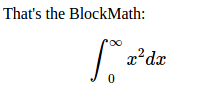Display math with KaTeX and ReactJS!
You can install it with npm:
$ npm install --save react-katexWith Yarn:
$ yarn add react-katexOr use one of the files inside the dist folder.
When using react-katex directly from the browser, react-katex will export a global called ReactKaTeX. Notice that the T and X from "KaTeX" are uppercased.
Don't forget to import KaTeX CSS file (see example/index.html).
If you open the example file on Firefox directly (i.e. without a server) the fonts won't load, open it on Chrome or put it on some server. You can use some static one-liner.
react-katex has two types of math components, InlineMath and BlockMath.
Display math in the middle of the text.
var InlineMath = ReactKaTeX.InlineMath;
ReactDOM.render(<InlineMath math="\\int_0^\\infty x^2 dx"/>,
document.getElementById('math'));
// or
ReactDOM.render(<InlineMath>\int_0^\infty x^2 dx</InlineMath>,
document.getElementById('math'));It will be rendered like this:
Display math in a separated block, with larger font and symbols.
var BlockMath = ReactKaTeX.BlockMath;
ReactDOM.render(<BlockMath math="\\int_0^\\infty x^2 dx"/>,
document.getElementById('math'));
// or
ReactDOM.render(<BlockMath>\int_0^\infty x^2 dx</BlockMath>,
document.getElementById('math'));It will be rendered like this:
By default the error rendering is handled by KaTeX. You can optionally pass errorColor (defaults to #cc0000) as a prop:
var BlockMath = ReactKaTeX.BlockMath;
ReactDOM.render(
<BlockMath
math={'\\int_0^\\infty x^2 dx \\inta'}
errorColor={'#cc0000'}
/>, document.getElementById('math'));This will be rendered like so:
It's possible to handle parse errors using the prop renderError. This prop must be a function that receives the error object and returns what should be rendered when parsing fails:
var BlockMath = ReactKaTeX.BlockMath;
ReactDOM.render(
<BlockMath
math="\\int_{"
renderError={(error) => {
return <b>Fail: {error.name}</b>
}}
/>,
document.getElementById('math'));
// The code above will render '<b>Fail: ParseError</b>' because it's the value returned from `renderError`.This will render <b>Fail: ParseError</b>:
In addition to using the math property, you can also quote as a child allowing the use of { } in your expression.
ReactDOM.render(<BlockMath>{"\\frac{\\text{m}}{\\text{s}^2}"}</BlockMath>,
document.getElementById('math'));Or Multiline
ReactDOM.render(<BlockMath>{`\\frac{\\text{m}}
{\\text{s}^2}`}</BlockMath>,
document.getElementById('math'));However, it can be annoying to escape backslashes. This can be circumvented with the String.raw tag on a template literal when using ES6.
ReactDOM.render(<BlockMath>{String.raw`\frac{\text{m}}{\text{s}^2}`}</BlockMath>,
document.getElementById('math'));Backticks must be escaped with a backslash but would be passed to KaTeX as \`. A tag can be created to replace \` with `
const latex = (...a) => String.raw(...a).replace("\\`","`")
ReactDOM.render(<BlockMath>{latex`\``}</BlockMath>,
document.getElementById('math'));You can even do variable substitution
const top = "m";
const bottom = "s";
ReactDOM.render(<BlockMath>{String.raw`\frac{\text{${top}}}{\text{${bottom}}^2}`}</BlockMath>,
document.getElementById('math'));


